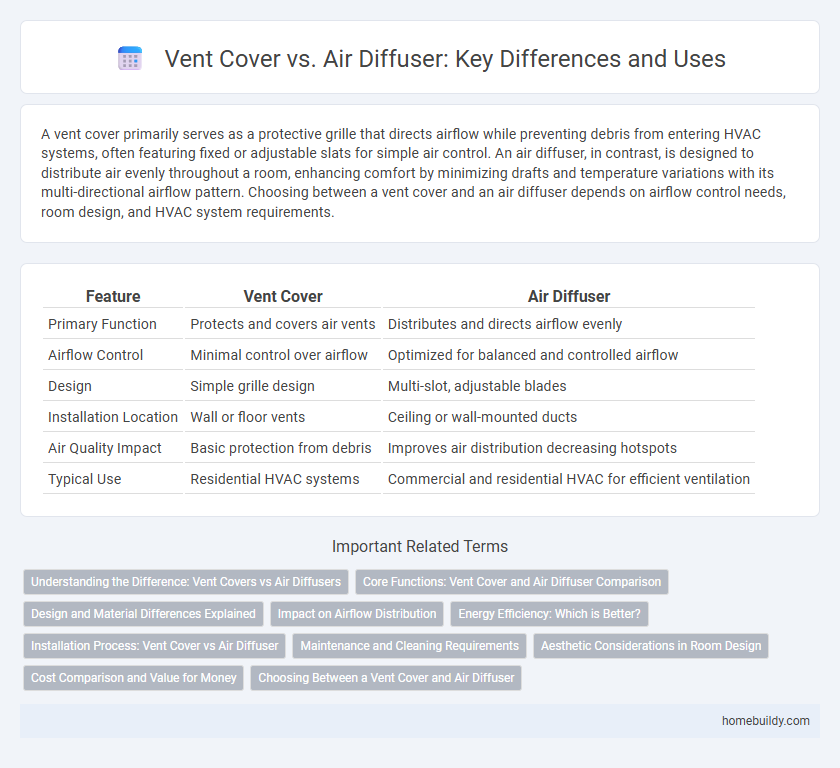A vent cover primarily serves as a protective grille that directs airflow while preventing debris from entering HVAC systems, often featuring fixed or adjustable slats for simple air control. An air diffuser, in contrast, is designed to distribute air evenly throughout a room, enhancing comfort by minimizing drafts and temperature variations with its multi-directional airflow pattern. Choosing between a vent cover and an air diffuser depends on airflow control needs, room design, and HVAC system requirements.
Table of Comparison
| Feature | Vent Cover | Air Diffuser |
|---|---|---|
| Primary Function | Protects and covers air vents | Distributes and directs airflow evenly |
| Airflow Control | Minimal control over airflow | Optimized for balanced and controlled airflow |
| Design | Simple grille design | Multi-slot, adjustable blades |
| Installation Location | Wall or floor vents | Ceiling or wall-mounted ducts |
| Air Quality Impact | Basic protection from debris | Improves air distribution decreasing hotspots |
| Typical Use | Residential HVAC systems | Commercial and residential HVAC for efficient ventilation |
Understanding the Difference: Vent Covers vs Air Diffusers
Vent covers primarily serve as protective grilles that cover duct openings, helping to prevent debris from entering HVAC systems while maintaining airflow control. Air diffusers are engineered to distribute conditioned air evenly throughout a room, optimizing ventilation efficiency and comfort by directing airflow patterns. Understanding the distinct functions of vent covers versus air diffusers enables better decisions for HVAC system performance and indoor air quality management.
Core Functions: Vent Cover and Air Diffuser Comparison
Vent covers primarily serve to protect and conceal duct openings while regulating airflow direction and preventing debris entry. Air diffusers optimize air distribution by evenly dispersing conditioned air throughout a room, enhancing ventilation efficiency and comfort. Compared to vent covers, air diffusers play a critical role in maintaining indoor air quality and temperature control by managing airflow patterns more precisely.
Design and Material Differences Explained
Vent covers typically feature simple, flat designs made from durable materials like aluminum or plastic, prioritizing basic airflow protection and ease of installation. Air diffusers are more complex, often crafted from metal or high-quality plastic with adjustable louvers or blades to optimize air distribution and enhance aesthetic appeal. The material choice and design intricacies in air diffusers aim to improve HVAC efficiency and interior design integration compared to the straightforward functionality of vent covers.
Impact on Airflow Distribution
Vent covers restrict airflow more than air diffusers, often causing uneven distribution and reduced efficiency in heating or cooling systems. Air diffusers are designed to spread air evenly across a room, minimizing drafts and maintaining consistent temperature control. Effective airflow distribution depends on selecting the appropriate device based on room size and HVAC system specifications.
Energy Efficiency: Which is Better?
Vent covers improve energy efficiency by sealing unused vents and preventing conditioned air from escaping, reducing HVAC load and lowering energy bills. Air diffusers optimize airflow distribution and maintain balanced room temperatures, enhancing overall system efficiency but do not prevent air leakage. For maximizing energy savings, vent covers are generally better at minimizing wasted energy in unused spaces, while air diffusers contribute primarily to airflow quality rather than direct energy conservation.
Installation Process: Vent Cover vs Air Diffuser
The installation process for vent covers is typically straightforward, involving secure attachment over existing vent openings using screws or clips, making it a quick and easy upgrade for air flow control. In contrast, air diffusers require precise placement and integration into the HVAC duct system, often necessitating professional tools and expertise to ensure optimal air distribution and performance. Proper installation of each component directly impacts airflow efficiency and indoor air quality, highlighting the importance of selecting the right fixture for specific ventilation needs.
Maintenance and Cleaning Requirements
Vent covers require minimal maintenance, typically involving periodic dusting and occasional washing to prevent debris buildup. Air diffusers demand more frequent cleaning due to their multiple slots and moving parts, which can accumulate dust and reduce airflow efficiency. Proper cleaning of both components ensures optimal indoor air quality and HVAC system performance.
Aesthetic Considerations in Room Design
Vent covers offer a sleek, minimalistic appearance that seamlessly blends into walls or ceilings, enhancing room aesthetics without drawing attention. Air diffusers, with their intricate designs and adjustable louvers, contribute to a dynamic visual element that can complement modern or industrial interior styles. Choosing between vent covers and air diffusers depends on balancing subtlety and design impact within the overall room decor.
Cost Comparison and Value for Money
Vent covers generally offer a more cost-effective solution compared to air diffusers, with lower initial purchase and installation expenses. While air diffusers provide advanced airflow control and aesthetic benefits, vent covers deliver practical functionality at a fraction of the cost. For budget-conscious projects, vent covers represent better value for money without sacrificing essential ventilation needs.
Choosing Between a Vent Cover and Air Diffuser
Choosing between a vent cover and an air diffuser depends on airflow control and room aesthetics. Vent covers provide a simple solution to block or redirect airflow in HVAC systems, while air diffusers evenly distribute air for enhanced comfort and noise reduction. Selecting the appropriate option requires evaluating ventilation needs, system compatibility, and design preferences.
vent cover vs air diffuser Infographic

 homebuildy.com
homebuildy.com